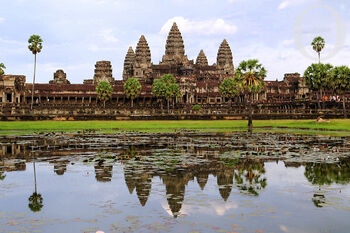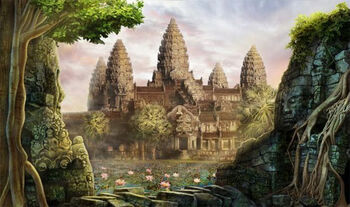Archaeological sites[]



Angkor is an archaeological site in Southeast Asia, in Cambodia. Stretching over some 400 km2, including forested area, Angkor Archaeological Park contains the magnificent remains of the different capitals of the Khmer Empire, from the 9th to the 15th century. They include the famous Temple of Angkor Wat and, at Angkor Thom, the Bayon Temple with its countless sculptural decorations. Archaeological excavations have discovered artifacts used by early humans, including stone tools, which suggest an extremely early date for human habitation and technology in the area.
Khmer Empire[]
The Khmer Empire (Khmer: ចក្រភពខ្មែរ) or the Angkor Empire (Khmer: ចក្រភពអង្គរ), was the powerful Khmer Hindu-Buddhist empire in Southeast Asia. The empire, which grew out of the former Kingdom of Funan and Chenla, at times ruled over most of mainland Southeast Asia, parts of modern-day Laos, Thailand, and southern Vietnam.
The legacy of the Khmer Empire is Angkor in present-day Cambodia, which was the site of the capital city during the empire's zenith. The monuments of Angkor — such as Angkor Wat and Bayon — bear testimony to the Khmer empire's immense power and wealth, impressive art and culture, architectural technique and aesthetics achievements, as well as the variety of belief systems that it patronised over time. Recently satellite imaging has revealed Angkor to be the largest pre-industrial urban center in the world.